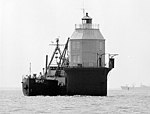Sandy Point Farmhouse
1815 establishments in MarylandAnne Arundel County, Maryland Registered Historic Place stubsHouses completed in 1815Houses in Anne Arundel County, MarylandHouses on the National Register of Historic Places in Maryland ... and 1 more
National Register of Historic Places in Anne Arundel County, Maryland

The Sandy Point Farmhouse is a historic home at Sandy Point State Park, Anne Arundel County, Maryland, United States. It is a five-part plan consisting of a two-story central block connected to two wings by single-story hyphens. It was built in an 18th-century style in the 19th century and typical of Maryland domestic architecture. The house was constructed about 1815 for John Gibson, a member of the Annapolis elite and a relative of Samuel Ogle, an 18th-century Governor of Maryland.The Sandy Point Farmhouse was listed on the National Register of Historic Places in 1972.
Excerpt from the Wikipedia article Sandy Point Farmhouse (License: CC BY-SA 3.0, Authors, Images).Sandy Point Farmhouse
South Beach Road,
Geographical coordinates (GPS) Address Website Nearby Places Show on map
Geographical coordinates (GPS)
| Latitude | Longitude |
|---|---|
| N 39.014444444444 ° | E -76.399444444444 ° |
Address
Sandy Point Mansion
South Beach Road
Maryland, United States
Open on Google Maps





